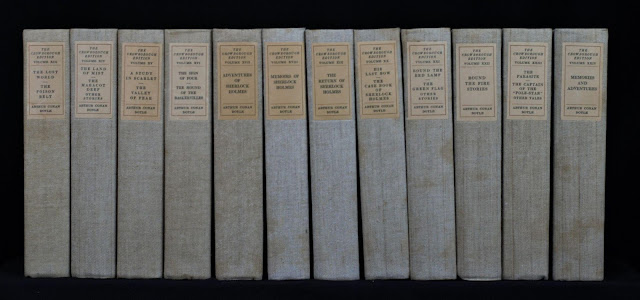One of the most significant Conan Doyle projects underway is the Edinburgh University Press edition of the works of Arthur Conan Doyle. A multi-volume decade-long endeavour, the project aims to produce definitive versions of the author’s major works, with scholarly introductions and annotations. Back in November 2019, the project team hosted the ‘Conan Doyle and London’ symposium at Senate House, which delved into the author’s relationship with the city, mostly through his fiction. The team’s second conference took place on 24-25 September 2020 on the theme of ‘Conan Doyle in Edinburgh,’ again touching on the many varied aspects of Conan Doyle’s professional and personal life, this time with a bent towards his formative years. This time a virtual conference, the event attracted an international audience, and we are fortunate that all the sessions were recorded so can now review them at your leisure.
The gothic featured heavily in the second panel which addressed ‘Conan Doyle in the Empire and Around the World.’ Jessica R. Valdez’s ‘Conan Doyle and the American West’ explored the author’s use of Eastern tropes in his depiction of the American West, suggesting that he harboured an anxiety around the USA and its diffused power. Paul M. Chapman (yes, that one!) spoke on ‘Anglo-Indian Gothic in Uncle Jeremy’s Household,’ in which he dissected the sources and influences on the story, particularly the Thuggee cult, and the inheritance owed by both The Mystery of Cloomber (1888) and The Sign of Four (1890) to this often overlooked classic. The panel concluded with the series editor, Douglas Kerr, talking on ‘Conan Doyle’s Desert Drama – the Fires of Fate,’ the play adaptation of The Tragedy of the Korosko (1898), which was first performed in 1909. Kerr noted the significant variances from the original tale, notably the greater focus on the inner and moral life of the protagonist, as the role of providence shifted from the guiding force behind Empire to the guiding force behind private lives. The post-panel discussion on Conan Doyle’s attitudes to Eastern religions and Imperial Gothic is also worth seeing.
The first day closed with a presentation from Ann Treherne,
author of ‘Arthur and Me,’ who described how her own psychic experience led to
establish the Sir Arthur Conan Doyle Centre in the centre of Edinburgh. While a
departure from the content of the two-day programme, Treherne’s talk reminded us
of the influence that Conan Doyle continues to have in the spiritualist
movement to this day.
The Edinburgh Works took centre stage at the start of day two for panel five on ‘Editing the New Critical Editions’ with contributing editors Andrew Glazzard (The Case of Sherlock Holmes), Darryl Jones (Conan Doyle - Gothic Tales), Jonathan Cranfield (Twentieth Century Victorian – Conan Doyle and the Strand Magazine) and series editor, Douglas Kerr (Conan Doyle: Writing, Profession and Practice). Kerr opened the session by noting that no other modern writer can rival Conan Doyle for breadth of work, and his writings now appear in university curricula within literary, cultural and imperial discourses. The Edinburgh Works project is a mammoth one, with twenty volumes anticipated. In creating the definitive texts, the editors have reviewed multiple editions, noting significant changes in the closing sections of Memories and Adventures (1924), contradictions in UK and US versions of The Noble Batchelor, and wrestling with where to include The Adventure of the Cardboard Box (1893). Darryl Jones spoke on the challenges of wrestling with the Imperial rhetoric of The Green Flag (1900) and extending imaginative sympathy to the author.
Darryl Jones chaired the final panel on ‘Sherlock Holmes in
Time and Space.’ Catherine Wynne gave a fascinating, wide-ranging paper on Conan
Doyle’s work during the First World War including His Last Bow (1917)
and A Visit to Three Fronts (1916) and touching on his relationship with
Casement in ‘Un Un Soldat dans l’armee Anglaise” – Sherlock Holmes on the Home
Front.’ Ashlee Simon’s ‘Speed and Stasis: Stimulants, Paralytics, and Narrative
Velocity in The Sign of Four,’ provided a novel take on Sherlock
Holmes’s drug use in that Holmes’s drug use is driven by rationality and not
emotion, and contrasting this with other stimulants in the canon such as
curare. Finally, Annette Wren touched on many of the themes raised in the
‘Conan Doyle and Cities’ panel in her exploration of the Charlotte Holmes
novels in ‘Re-Visioning the Detective Flaneur: Sherlock Holmes to Charlotte
Holmes.’
The programme ended with a discussion of two pre-recorded keynotes which were issued to attendees in advance. Nick Daly’s ‘Love and Mormonism: The Origins of A Study in Scarlet,’ despite traversing well-trodden ground, introduced several new perspectives on the influences on Conan Doyle, notably from the works by E. M. Murdoch and A. K. Green, also published by Ward, Lock and Co. Daly’s survey also took in Fanny Stenhouse’s A Lady’s Life Among the Mormons (1872), the dime novels of the 1870s and 1880s, plus several early films and plays that reflected the moral panic including The Danites which played in Portsmouth in 1882.
In the second keynote, Owen Dudley Edwards explored Conan Doyle’s close association with Edinburgh. A lecture of astonishing breadth and erudition, Edwards took as his central theme Conan Doyle as scholar, beginning with the author’s decision to go beyond the ordinary medical degree to obtain an MD and how his scholarly training and outlook influenced his life and work. Edwards noted the debt owed to many people – Scott and Macaulay, but also John Hill Burton, William Burton, and a cast of characters from his youth – and how these exerted often competing pressures on Conan Doyle’s identity as illustrated within the poem, ‘The Inner Room’ (1897). Perhaps more than any other speaker, Edwards’ firmly located Conan Doyle in Edinburgh, as the symposium intended.
Mark Jones
Links:
Conference abstracts and speaker biographies










Comments
Post a Comment